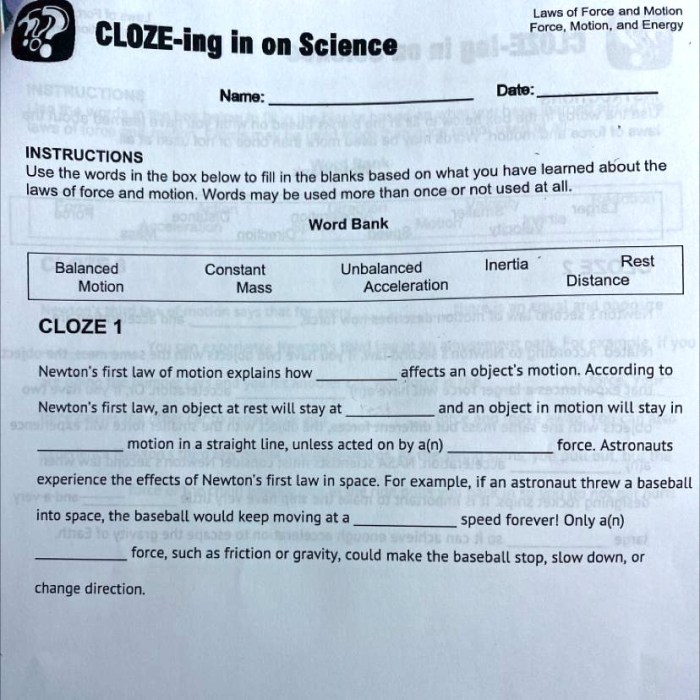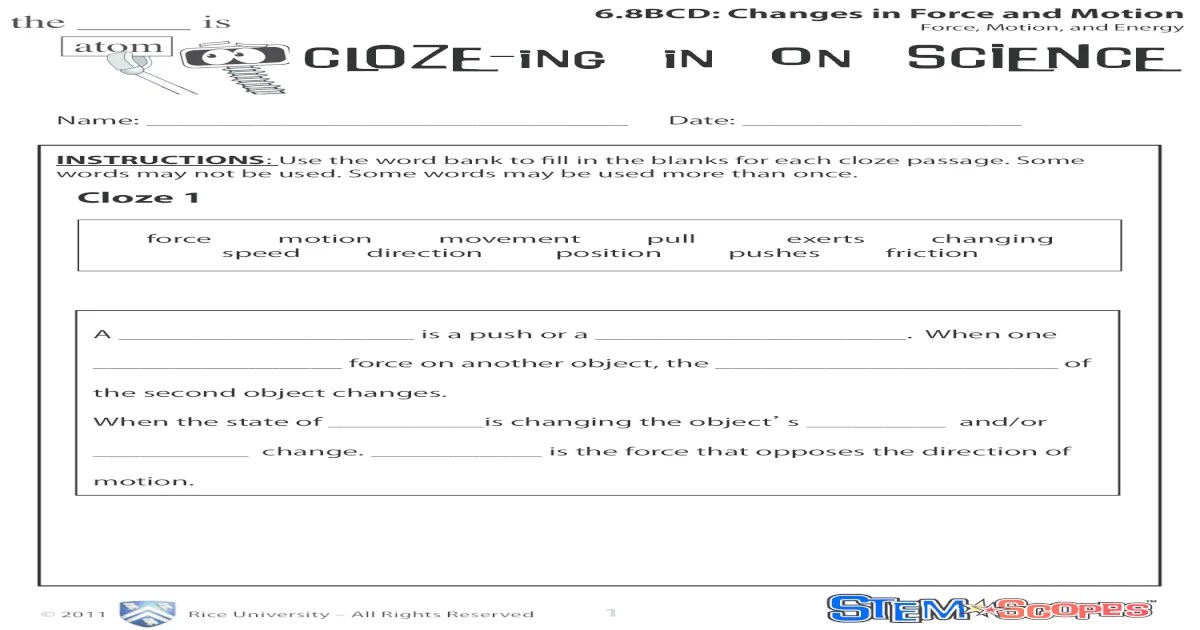Cloze ing in on science – Cloze in on science, an innovative approach that combines education and research, is transforming the way we engage with scientific concepts and advance knowledge. By fostering critical thinking, fostering collaboration, and bridging disciplines, this approach unlocks new possibilities for scientific exploration and societal progress.
From its historical roots to its contemporary applications, cloze in on science has proven to be a powerful tool for understanding and shaping the world around us.
Contextualizing ‘Closing in on Science’
The term ‘closing in on science’ encompasses an educational and research approach that emphasizes the gradual acquisition of scientific knowledge and skills through a series of iterative steps. This approach recognizes that scientific understanding is not static but rather a dynamic and evolving process that requires ongoing inquiry, experimentation, and refinement.
Historically, the concept of ‘closing in on science’ emerged in the late 19th century as a reaction to the limitations of traditional science education, which often focused on rote memorization and isolated facts. Educational reformers such as John Dewey and Jerome Bruner advocated for a more inquiry-based approach that would allow students to actively engage with scientific concepts and develop their own understanding through experimentation and observation.
Impact on Scientific Advancements
The ‘closing in on science’ approach has had a significant impact on scientific advancements by fostering a culture of critical thinking, problem-solving, and innovation. By providing students with the opportunity to engage in hands-on investigations and collaborative projects, this approach encourages them to develop the skills and dispositions necessary for scientific inquiry.
This has led to a generation of scientists who are more adept at asking questions, designing experiments, and interpreting data, ultimately contributing to the advancement of scientific knowledge and technological breakthroughs.
Pedagogical Implications: Cloze Ing In On Science

The “closing in on science” approach offers a unique and effective way to engage students in science learning. By fostering a sense of curiosity and encouraging students to actively participate in the scientific process, this approach can help to develop critical thinking skills, problem-solving abilities, and a deeper understanding of scientific concepts.
Implementing “Closing in on Science” in Classrooms
Implementing the “closing in on science” approach in classrooms can be done in a variety of ways. One effective method is to use hands-on activities and experiments that allow students to experience the scientific process firsthand. For example, students could be tasked with designing and conducting an experiment to test the effects of different variables on plant growth.
Through this activity, students would learn about the importance of variables, data collection, and hypothesis testing.
Cloze ing in on science is a great way to learn about the subject, and there are many resources available to help you. One helpful resource is us history 1301 exam 1 , which provides practice questions and answers to help you prepare for your exam.
Cloze ing in on science can be a challenging but rewarding experience, and with the right resources, you can succeed.
Fostering Student Engagement and Critical Thinking
Another key aspect of the “closing in on science” approach is fostering student engagement and critical thinking. This can be done by encouraging students to ask questions, share their ideas, and engage in discussions with their peers. Teachers can also provide opportunities for students to present their findings to the class, which can help to develop their communication and presentation skills.
Potential Challenges and Solutions
While the “closing in on science” approach offers many benefits, there are also some potential challenges that teachers may face. One challenge is ensuring that all students have the necessary background knowledge and skills to participate fully in the activities.
Another challenge is managing the time required for hands-on activities and experiments. To address these challenges, teachers can provide differentiated instruction and support to students who need it, and they can plan carefully to ensure that activities are appropriate for the time available.
Research Applications

The ‘closing in on science’ approach plays a crucial role in advancing scientific knowledge by enabling researchers to refine their hypotheses and focus their investigations. It involves iteratively testing and refining ideas, leading to a deeper understanding of scientific phenomena.
This approach can lead to new discoveries and innovations by allowing researchers to identify patterns, test predictions, and develop new theories. It promotes a systematic and rigorous approach to scientific inquiry, increasing the likelihood of groundbreaking findings.
Case Studies, Cloze ing in on science
Numerous successful research projects have utilized ‘closing in on science’ methodologies, resulting in significant advancements. One notable example is the discovery of the Higgs boson particle at the Large Hadron Collider (LHC). Scientists used the ‘closing in on science’ approach to refine their predictions and design experiments that ultimately led to the particle’s detection.
Another example is the development of gene-editing technologies like CRISPR-Cas9. Researchers employed the ‘closing in on science’ approach to refine their understanding of gene function and develop techniques for precise genetic modifications.
Interdisciplinary Connections
Exploring the connections between ‘closing in on science’ and other disciplines offers a holistic and comprehensive approach to understanding the complexities of science. Interdisciplinary perspectives can illuminate the historical, philosophical, and technological contexts that shape scientific inquiry, leading to a deeper appreciation and understanding of the scientific process.
History
Historical perspectives provide context for the evolution of scientific ideas and discoveries. By examining the historical roots of scientific concepts, we can trace their development and understand how they have influenced our current understanding of the world. For instance, studying the history of astronomy reveals the gradual shift from geocentric to heliocentric models, highlighting the role of empirical evidence and the scientific method in shaping our understanding of the cosmos.
Philosophy
Philosophy examines the fundamental nature of science and knowledge. Philosophical inquiries into the nature of scientific inquiry, objectivity, and truth can challenge our assumptions about the scientific process. For example, philosophical discussions on the role of induction and deduction in scientific reasoning can help us understand the limits and strengths of scientific methods.
Technology
Technology is an integral part of modern science, enabling scientists to collect, analyze, and interpret vast amounts of data. The development of new technologies, such as advanced imaging techniques and computational tools, has expanded our ability to observe and understand natural phenomena.
Interdisciplinary collaborations between scientists and engineers can lead to innovative technological solutions that enhance scientific research and discovery.
Collaboration and Cross-Disciplinary Research
Interdisciplinary connections foster collaboration and cross-disciplinary research, where researchers from different fields combine their expertise to address complex scientific challenges. For example, collaborations between biologists, computer scientists, and engineers have led to the development of sophisticated bioinformatics tools that facilitate the analysis of genetic data.
Such cross-disciplinary collaborations can break down disciplinary silos and lead to novel insights and breakthroughs.
Ethical Considerations
As scientific advancements continue to push the boundaries of knowledge, it is crucial to address the ethical implications of ‘closing in on science.’ Responsible research practices are paramount to ensure that scientific pursuits align with societal values and benefit humanity.
One ethical consideration is the potential misuse of scientific knowledge for harmful purposes. For instance, advances in biotechnology could be exploited to create biological weapons or enhance human beings in ways that raise questions about equity and justice.
Mitigating Potential Risks
- Transparency and Public Engagement:Fostering open dialogue and involving the public in decision-making processes can help ensure that scientific advancements are aligned with societal values.
- Ethical Guidelines and Oversight:Establishing clear ethical guidelines and implementing oversight mechanisms can help prevent the misuse of scientific knowledge and ensure responsible conduct.
- Education and Training:Providing education and training to researchers on ethical principles and responsible research practices can promote ethical decision-making.
FAQ Resource
What is the main goal of cloze in on science?
To foster a comprehensive understanding of scientific concepts through a collaborative and interdisciplinary approach.
How can cloze in on science be implemented in classrooms?
By incorporating hands-on experiments, group discussions, and critical analysis of scientific literature.
What are the benefits of cloze in on science for research?
It enables researchers to approach problems from multiple perspectives, leading to innovative solutions and new discoveries.